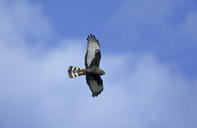
Name
Black harrier - Circus maurus
Black Harrier Appearance
The black harrier looks all black when perched, with yellow legs and a yellow eye and cere. When the black harrier is in flight, a white rump, a black and white striped tail and white flight feathers are visible. The male and female are very similar in appearance, other than the female being around 20% larger than the male.
The black harrier is around 50 cm in length.
Diet
The black harrier’s main food source is small rodents or mammals. This harrier will occasionally take small to medium birds and small reptiles. Prey is caught on the ground. Hunting takes place by flying low over its hunting ground.
Black Harrier Breeding
The black harrier is monogamous. A nest of dried vegetation is built on the ground. A clutch of three to five eggs are laid and hatch around 30 days later. The chicks fledge around 40 days later.
The black harrier nests in loose colonies of 3 to 15 pairs, with nests as close as 50 m apart.
Black Harrier Behaviour
The black harrier is normally seen flying low over the surrounding vegetation while hunting.
Threats
The black harrier is an endemic raptor that is become a rare sighting.
The black harrier is classed as endangered in South Africa. The main threat to the black harrier is habitat loss or change, caused by urbanisation, agriculture and invasive alien plants. The overuse and high demand on the use of pesticides on agricultural land is having a negative effect on the species.
Black Harrier Distribution and Habitat
The black harrier has a restricted distribution that is mainly centred around the Karoo, fynbos and renosterveld areas of the Eastern and Western Cape. Non-breeding populations are found around the grasslands of the Free State and Lesotho.
The best location to see a black harrier is the West Coast National Park, in the Western Cape.